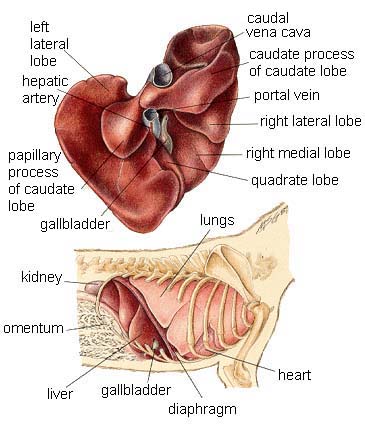Table of Contents
Summary:
"Canine liver failure has multiple causes including infection, parasites, cancer and toxic substances. Diagnosis for liver problems can be challenging. Treatment includes changes in diet matched to the severity of the disease."
Overview
Dog liver failure problems can be caused by a number of things, including viral and bacterial infections, parasites, cancer, obstructive bile duct disease, and toxic reactions. The reason the liver is failing may affect to some degree the symptoms and the treatment required.
Canine Liver Failure Symptoms
Symptoms of liver failure in dogs include:
- Abdominal distention (caused by an enlarged liver and/or fluid build-up in the abdomen)
- Weight loss
- Loss of appetite
- Jaundice (the whites of the eyes will appear yellowish in color)
- Lethargy
- Vomiting
- Diarrhea
- Increase in drinking
- Increase in urination
Canine Liver Failure Diagnosis
Tests are used to test the level of liver enzymes in the blood. Abnormal liver enzymes do not necessarily mean that liver disease is present, particularly if your dog is taking medications for other conditions.
Another important principle that should be kept in mind when evaluating the patient with abnormal liver enzymes is that the liver has a great reserve capacity and clinical signs of liver disease often do not appear until the disease is quite advanced. Similarly liver function tests become abnormal only when significant liver dysfunction is present.
There is no ideal liver function test to tell the degree of liver damage. Tests of the urine or blood serum enzyme levels measure the efficiency of bile acid circulation. Abnormal bile acid concentrations indicate the presence of abnormal connections between the portal vein and the hepatic vein and overall liver function problems.

Your vet will examine your dog carefully, including feeling his abdomen to feel for the size of his liver. If canine liver failure is suspected, x-rays can be taken to show the size of the liver and to look for tumors. Gallstones will also show up on the x-rays, if those are present. An ultrasound can also be used to visualize the liver and gallbladder.
For a better diagnosis, your veterinarian might do a fine needle biopsy, to take a sample of liver tissue for testing as safely as possible.
Canine Liver Failure Treatment
Treatment for canine liver failure depends on the cause. In many cases, treatment is limited to supportive therapy, which includes IV fluids, medications to prevent vomiting, and a special diet if the dog is able to eat. If the dog is not able to eat, a feeding tube may be placed.
Corticosteroids are sometimes used to decrease
inflammation of the liver, but must be used with care because in large
doses, they can actually cause liver damage. The liver is the organ that
breaks down medication in the body, and it doesn't do this efficiently
when it is diseased, so smaller than normal doses must be given.
Antibiotics are often given to prevent secondary bacterial infections, and medications are often given to prevent vomiting and ulcers. In addition, if there is fluid build-up in the abdomen, diuretics are given; otherwise the fluid build-up will cause difficulty breathing as the fluid puts pressure on the diaphragm.
A special canine liver disease diet may be needed for dogs with canine liver failure. The diseased liver has trouble producing enough protein. A diet might be needed that overcompensates with food such as beef and animal protein sources. Commercial diets made for dogs with liver disease such as Hill's Prescription Diet l/d are fortified with the needed vitamins such as antioxidants such as Vitamin E, C, and K.
Additional supplements that contain the ingredients Milk Thistle, Burdock and Greater Celandine such as PetAlive Liver-Aid are made for this purpose and are worth exploring. It is a good idea to review all choices with your veterinarian so that your dog's diet can be calibrated to the severity of the liver disease, and so that your vet can track any progress your dog is making.
Sources
Diagnosing Liver Disease in Dogs
Maddison, Jill
Canine Liver Disease
D. Twedt
Colorado State University
Note: The pictures in this section are reprinted with permission by the copyright owner, Hill's Pet Nutrition, from the Atlas of Veterinary Clinical Anatomy. These illustrations should not be downloaded, printed or copied except for personal, non-commercial use.
